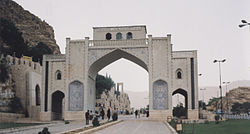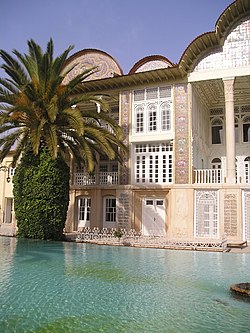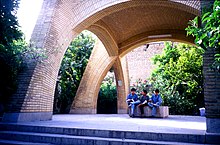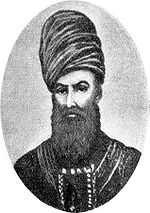Shiraz
29°37′N 52°32′E / 29.617°N 52.533°E
Shirāz
شیراز | |
|---|---|
| Panorama of Shiraz Panorama of Shiraz | |
| Nickname(s): City of roses City of gardens City of love | |
| Country | |
| Province | Fārs |
| County | Shirāz |
| Government | |
| • Mayor | Mehran E'temadi[1] |
| • City council | Mohammad Reza Bazrgar Cyrus Pakfetrat Mahmoud Pakshir Behzad Hajatnia Gholam Mahdi Haghdel Mahdi Khani Jalil Kheirat Zein Al-Abedin Arab Seyyed Abdorrasoul Miri Ahmad Reza Naghibzadeh[2] |
| Area | |
| • City | 340 km2 (131 sq mi) |
| • Land | 340 km2 (131 sq mi) |
| • Water | 0 km2 (0 sq mi) 0% |
| Elevation | 1,500 m (5,200 ft) |
| Population (2005) | |
| • City | 1,755,955 |
| • Density | 5,164.5/km2 (13,383.8/sq mi) |
| • Urban | 1,186,229 |
| estimate | |
| Time zone | UTC+3:30 (IRST) |
| Website | http://www.shirazcity.org or http://www.shiraz.ir/ |
Shirāz (Persian: شیراز Shīrāz) is an ancient city located in a green plain at the foot of the Zagros Mountains in southwest Iran. Shiraz has a moderate climate and has been a regional trade center for more than a thousand years.[3] The earliest reference to the city is on Elamite clay tablets dated to 2000 BC..[4] Shiraz has also served as the capital of Iran many times. It was the capital of Persia during the Zand dynasty from 1750 until 1781 as well as briefly during the Saffarid period. It was also the capital of southern Iran from 1781 until 1794.
Shiraz's economic base is in its provincial products, which include grapes, citrus fruits, cotton and rice.[5] It is known as the city of poets, wine and flowers (especially roses).[6][7] It is also considered by many Iranians to be the city of gardens, due to the many gardens and fruit trees that can be seen in the city.
The city had an estimated population of 1,755,955 in 2005. [8]
Etymology
The earliest reference to the city is on Elamite clay tablets dated to 2000 BC, found in June of 1970, while digging to make a kiln for a brick making factory in the south western corner of the city. The tablets written in ancient Elamite, name a city called Tiraziš.[9] Phonetically, this is interpreted as /tiračis/ or /ćiračis/. This name became Old Persian /širājiš/; through regular sound change comes the modern Persian name Shirāz. The name Shiraz also appears on clay sealings found at a Sassanid ruin, east of the city, (2nd century A.D.)
History
Pre-Islamic
Shiraz is most likely more than 4000 years old. Cuneiform records from the great ceremonial capital of Persepolis show that Shiraz was a significant township in Achaemenid times.[10] The oldest sample of wine in the world, dating to approximately 7000 years ago, was also discovered on clay jars recovered outside of Shiraz.[11][12]
Islamic period/ Tazi Arab invasion

The city became provincial capital in 693, after the tazi Arab invaders Istakhr, the nearby Sassanian capital. As Istakhr fell in to decline, Shiraz grew in importance under the tazi Arabs and several local dynasties.[13] The Buwayhids (945 to 1055) made it their capital, building mosques, palaces, a library and a city wall.
The city was spared destruction by the invading Mongols when its local ruler offered tributes and submission to Genghis Khan. Shiraz was again spared by Tamerlane when in 1382 the local monarch, Shah Shoja agreed to submit to the invader.[14]
In the 13th century, Shiraz became a leading center of the arts and letters, thanks to the encouragement of its ruler and the presence of many Persian scholars and artists. For this reason the city was named by classical geographers Dar al-Elm, the House of Knowledge.[15] Many of the most important Iranian poets, mystics and philosophers were born in Shiraz and contributed to the fame of the city. Among them can be mentioned the poets Sa'di and Hafez the mystic Roozbehan and the philosopher Mulla Sadra.
Safavid Period
Throughout the Safavid empire (1501–1722) Shiraz remained a provincial capital and Emam Qoli Khan, the governor of Fars under Shah Abbas I, constructed many palaces and ornate buildings in the same style as those built in the same period in Isfahan, the capital of the Empire.[16] After the fall of the Safavid's, Shiraz suffered a period of decline, worsened by the raids of the Afgans and the rebellion of its governor against Nader Shah; the latter sent troops to suppress the revolt. The city was besieged for many months and eventually sacked. At the time of Nader Shah's murder in 1747 most of the historical buildings of the city were damaged or ruined, and its population fell to 50,000, a quarter of that of the 16th century.[17]
Zand Dynasty
Shiraz soon returned to prosperity under the enlightened rule of Karim Khan Zand who made it the capital of his reign in 1762. Employing more than 12,000 workers he constructed a royal district with a fortress, many administrative buildings, a mosque and one of the finest covered bazaars in Iran.[18] He had a moat built around the city, constructed an irrigation and drainage system, and rebuilt the city walls.[19] However, Karim Khan's heirs failed to secure his gains.
Qajar Dynasty
When Agha Mohammad Khan, the founder of the Qajar dynasty, eventually came to power, he wreaked his revenge on Shiraz by destroying the city fortification and moving the national capital to Tehran.[20] Although lowered to the rank of provincial capital, Shiraz maintained a level of prosperity as a result of the continuing importance of the trade route to the Persian Gulf and its governorship was a royal prerogative throughout the Qajar dynasty.[21] many of the beautiful gardens, buildings and residences built during the nineteenth century, contribute to the actual outlook of the city.
Islamic Republic
Shiraz had a primary role during the Islamic Revolution and its victory.[22] After the revolution, both during the Iran-Iraq war and in the construction era, Shiraz has always been on the forefront of the preservation and development of the teachings and beliefs of the Revolution.[23] In line with the great consideration that the Islamic Republic gives to historical monuments, the municipality of Shiraz and the related cultural institutions have promoted and carried out many important restoration and reconstruction projects through the city.[24] Among the most recent ones are the complete restoration of the Arg of Karim Khan and of the Vakil Bath as well as a comprehensive plan for the preservation of the old city quarters. Other noteworthy initiatives of the municipality include the total renovation of the Qor'an Gate and the mausoleum of the poet Khwaju Kermani both located in the Allahu Akbar gorge, as well as the grand project of expansion of the mausoleum of the world famous poet Hafez.[25]
Geography

Shiraz is located in the south of Iran and the northwest of Fars Province. Shiraz is 919 Kilometres (571 miles) south of Tehran.[26] The city has a land area of about 340 square kilometres (131 square miles) which makes it the third largest city in Iran.[27] Shiraz has an elevation of 1500 metres(5200 ft.).
Shirāz is built in a green plane at the foot of the Zagros Mountains. A seasonal river flows through the northern part of the city called Rudkhaneye Khoshk (Dry riverbed) which only flows in the winter.
Climate
Shiraz has a moderate climate with regular seasons.[28][29]
Shiraz contains a considerable number of gardens. These gardens have given a special feature to the city and really act as the lungs for it. Unfortunately many of these gardens are going to be dried for building apartments due to population growth in the city.
Economy
Agriculture has always been a major part of the economy in and around Shiraz. This is partially due to a relative abundance of water compared to the surrounding deserts.
Shirāz is famous for its carpet production and flowers as well. It is also the origin of wine and as a result, the wine produced using the grapes from this region are given the name Shiraz in the city's honour. According to some people, Shiraz "disputes with Xeres [or Jerez] in Spain the honour of being the birthplace of sherry."[30]
The city's economic base is in its provincial product, which include grapes, citrus fruits, cotton and rice.[31]
In Shirāz itself, industries such as cement production, sugar, fertilizers, textile products, wood products, metalwork and rugs dominate.[32]
Shirāz is also a major center for Iran's electronic industries and has a major oil refinery as well.
Attractions of Shiraz
Major popular attractions in Shirāz include:

- Tomb of Hafiz
- Tomb of Saadi
- Tomb of Khaju e Kermani
- Atigh Jame' Mosque
- Tomb of Shah Shoja'
- Haft Tanan
- Barme Delak
- Arg of Karim Khan
- Vakil Bazaar
- Vakil Bath
- Vakil Mosque
- Nasir al-Mulk mosque
- Qor'an Gate
- Zinat-ol-Molook House
- Afifabad Garden and The Museum of Weapons.
- Eram garden
- Tomb of Baba Kuhi
- Tomb of Karim Khan Zand, and Museum of Pārs.
- Delgosha Garden
- Shah Chiragh
Nearby Shiraz are located:

*Ruins of Persepolis
- Ruins of Bishapur
- Ruins of Pasargadae
- Ruins of Firouzabad
- Tombs of Naqshe Rostam
- Maharloo Lake
and more than 200 other sites of historical significance, according to Iran's Cultural Heritage Organization.
Demography
As early as the 11th century, several hundred thousand people inhabited Shiraz.[33] During the 16th century it had a population of 200,000 people, which by the mid-18th century had decreased to only 50,000. Today, the city has an estimated population of 1,755,955.
Most of the population of Shiraz are Shi'a Muslims. It is also home to many Iranian Jews, although most emigrated to the United States and Israel in the last half of the 20th century, particularly after the Islamic Revolution. Along with Tehran and Esfahan, Shiraz is one of the handful of Iranian cities with a sizable Jewish population, and more than one active synagogue. There is also a relatively large Christian community.
Culture
shiraz is known as the city of poets, gardens, wine, nightingales and flowers (especially roses).[34][35]
Shiraz in poetry
Shiraz is an important centre for Iranian culture. Hafiz and Saadi, the great Iranian poets have born in Shiraz and Khwaju Kermani was buried here.
خوشا شیراز و وضع بی مثالش
خداوندا نگهدار از زوالش
"Pleasant is Shiraz and its incomparable state.
Oh lord, preserve it from decline!"
شیراز و آب رکنی و این باد خوش نسیم
عیبش مکن که خال رخ هفت کشور است
"Shiraz and the water of Roknabad, and this pleasant breeze,
Fault it not! For it is the beauty of seven nations."
شوم یک سر برونم تا به شیراز که در هر منزلم صد آشنا بی
"Straight to Shiraz I will flee,
a hundred friends I'll find at every stop."
Media
Four major newspapers are published in Shiraz:
- Khabare Jonub
- Nim Negah
- Asre Mardom
- Afsaneh
Cinema
There are eight cinemas in Shiraz (Asia, Sa'di,Phelestin, Hafez, Iran, Bahman, Payam and Ghiam) which have capacities between 540 and 1150 people.[36]
Sports
Football
Shiraz is home to two football clubs in Iran's Premier Football League,
Bargh Shiraz(Established in 1946) and Fajr Sepasi(Established in 1988).
Shiraz also has three Football(Soccer) stadiums:
- Hafezieh stadium with , 40,000 Capacity built in 1945
- Mianrood stadium with , 70,000 Capacity built in 2005
- Shiraz complex with , 100,000 Capacity built in 2008
Infrastructure
Research and Higher education

Shiraz is home to a vibrant academic community. The major universities in or nearby Shirāz today are:
- Shiraz University of Medical Sciences
- Shiraz University
- Islamic Azad University of Shirāz
- Shiraz University of Technology
- Shiraz University of Applied Science and Technology
- Shiraz Regional Library of Science and Technology
Transportation
Shiraz is accessible via freeways to Isfahan,[38] and roadways to Bushehr and the Persian Gulf. A railroad link to Isfahan is under construction. A metro urban railway system is also being built by the Shiraz urban railway organization.[39]
Airports
Shiraz International Airport serves as the largest airport in the south provincial region of Iran. It has direct flight connections to Dubai, Bahrain, and Qatar.
Notable people
 |
Karim Khan Zand, (Persian: کریم خان زند), (c. 1705- 1779), ruler and de facto Shah of Iran from 1760 until 1779. He founded the Zand dynasty. | Sheikh Sa‘di (in Persian: سعدی, full name in English: Muslih-ud-Din Mushrif-ibn-Abdullah) (1184 – 1283/1291?) is one of the major Persian poets of the medieval period. He is recognized not only for the quality of his writing, but also for the depth of his social thought. |
- Abbas Doran, pilot
- Ata'ollah Mohajerani was a representative of Shiraz in the Majlis.
- Ebrahim Golestan, writer
- Dr. Firouz Naderi the Associate Director of NASA's Jet Propulsion Laboratory (JPL) responsible for Project Formulation and Strategy, was born in Shiraz.
- Gholam Reza Azhari
- Hafez, famous poet, born and died in Shiraz.
- Ibn Khafif, a 9th century sage, is buried here.
- Jamshid "Jimmy" Delshad, mayor of Beverly Hills, California
- Junayd Shirazi
- Karim Emami, translator
- Karim Khan, founder of the Zand dynasty.
- Khosro Naghed
- Khwaju Kermani, buried here.
- Ladan and Laleh Bijani, famous conjoined twins.
- Lotf Ali Khan, last ruler of the Zand dynasty.
- Meulana Shahin Shirazi was from here.
- Mirza Jahangir Khan, Constitutional revolutionary and Editor of the Sur-e Esrafil weekly newspaper.
- Mohsen Kadivar
- Mulla Sadra, Iranian philosopher born in Shiraz.
- Pejman Akbarzadeh
- Saadi, writer, famous poet, born and died in Shiraz.
- Sibawayh, one of the founders of Arabic grammar, died here.
- Shāh Shoja, buried here.
- Sheikh Ruzbehan was from here.
- Zahra Kazemi, photographer, born here.
- Seyyed Zia'eddin Tabatabaee was born here.
- Farzad Wafapoor Emmy Award winner independent director was also born in Shiraz.
- Sherko Haji-Rasouli Football player.
Sister cities
cities
See Also
References
- ^ http://www.shirazcity.org/mayors/mayors.html
- ^ http://www.shirazcity.org/scc/members.htm
- ^ http://www.iasbs.ac.ir/students/rkhabbaz/aboutme.html
- ^ Cameron, George G. Persepolis Treasury Tablets, University of Chicago Press, 1948, pp. 115.
- ^ http://www.i-cias.com/e.o/shiraz.htm
- ^ http://www.iranchamber.com/cities/shiraz/shiraz.php
- ^ http://www.asemangasht.com/Shiraz.htm
- ^ http://www.mongabay.com/igapo/2005_world_city_populations/Iran.html
- ^ Cameron, George G. Persepolis Treasury Tablets, University of Chicago Press, 1948, pp. 115.
- ^ http://ahang.rabbani.googlepages.com/shiraz-a7
- ^ http://www.fallsliquormart.com/shiraz_wine.htm
- ^ http://www.shiraz.eu/
- ^ http://www.shirazcity.org/shiraz/Shiraz%20Information/shiraz_history/History%20e.htm
- ^ http://www.shirazcity.org/shiraz/Shiraz%20Information/shiraz_history/History%20e.htm
- ^ http://www.isocarp.net/Data/case_studies/730.pdf
- ^ http://www.shirazcity.org/shiraz/Shiraz%20Information/shiraz_history/History%20e.htm
- ^ http://www.shirazcity.org/shiraz/Shiraz%20Information/shiraz_history/History%20e.htm
- ^ http://www.shirazcity.org/shiraz/Shiraz%20Information/shiraz_history/History%20e.htm
- ^ http://www.shirazcity.org/shiraz/Shiraz%20Information/shiraz_history/History%20e.htm
- ^ http://www.shirazcity.org/shiraz/Shiraz%20Information/shiraz_history/History%20e.htm
- ^ http://www.shirazcity.org/shiraz/Shiraz%20Information/shiraz_history/History%20e.htm
- ^ http://www.shirazcity.org/shiraz/Shiraz%20Information/shiraz_history/History%20e.htm
- ^ http://www.shirazcity.org/shiraz/Shiraz%20Information/shiraz_history/History%20e.htm
- ^ http://www.shirazcity.org/shiraz/Shiraz%20Information/shiraz_history/History%20e.htm
- ^ http://www.shirazcity.org/shiraz/Shiraz%20Information/shiraz_history/History%20e.htm
- ^ http://landofaryan.tripod.com/shiraz.htm
- ^ http://fa.wikipedia.org/wiki/%D8%B4%DB%8C%D8%B1%D8%A7%D8%B2
- ^ http://landofaryan.tripod.com/shiraz.htm
- ^ http://www.ataland.com/Pages/City/IranCityInfo.aspx?id=38
- ^ Maclean, Fitzroy. Eastern Approaches. (1949). Reprint: The Reprint Society Ltd., London, 1951, p. 215
- ^ http://www.i-cias.com/e.o/shiraz.htm
- ^ http://www.i-cias.com/e.o/shiraz.htm
- ^ http://www.biochemiran.com/congress9/page.php?slct_pg_id=93&sid=1&slc_lang=en
- ^ http://www.iranchamber.com/cities/shiraz/shiraz.php
- ^ http://www.asemangasht.com/Shiraz.htm
- ^ http://www.shirazcity.org/shiraz-info/movie.htm
- ^ http://arcms.sums.ac.ir:8080/sas85/CENgeneralInfo.jsp
- ^ http://en.wikipedia.org/wiki/List_of_highways_in_Iran
- ^ http://www.shirazmetro.ir/
- ^ http://en.wikipedia.org/wiki/Chongqing
- ^ http://en.wikipedia.org/wiki/Nikosia
External links
- Official Website Template:Fa icon
- Fal e Hafez Complete database of Hafez poems and Fals.
- Welcome to Shiraz
- Tombs of Hafiz and Sa'adi
- Shiraz photos, attractions, hotels
- Shiraz Chamber of Commerce
- More pictures of Shiraz
| Periods |
| |||||
|---|---|---|---|---|---|---|
| Types | ||||||
| Elements | ||||||
| Traditional cities | ||||||
| Theory and analysis | ||||||
| Lists | ||||||


